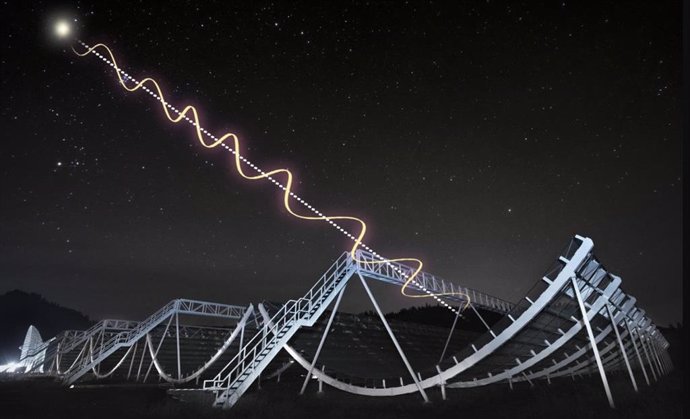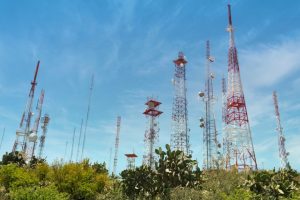Artist’s rendering of how the angle of polarized light from an FRB changes as it travels through space. – DUNLAP INSTITUTE.
June 11 () –
What scientists thought until now about the origin of the mysterious FRB (Fast Radio Burst) cosmic signals is only the tip of the icebergaccording to a study led by the University of Toronto.
The mysteries of millisecond-long cosmic explosions are being unlocked with a new way of analyzing data from the Canadian Hydrogen Intensity Mapping Experiment (CHIME).
Published in The Astrophysical Journal, the study details the properties of polarized light from 128 non-repetitive FRBs (i.e., from sources that have only produced a single burst to date). The study finds that they appear to come from galaxies like our Milky Way, with modest densities and magnetic fields.
Previous FRB studies have focused on much smaller samples of hyperactive repetitive sources that, in contrast, they appear to originate in dense, extremely magnetized environments. Only about 3% of known FRBs are repeats and come from a source that has produced multiple bursts since they were discovered.
Most radio telescopes can only see small spots in the sky, which makes it easier to focus on repeating FRBs with known positions. CHIME can survey an extremely large area of the sky to detect both repetitive and non-repeating FRBs.
“This was the first look at the other 97%,” he says it’s a statement lead author Ayush Pandhi, a doctoral student at the Dunlap Institute for Astronomy and Astrophysics and the David A. Dunlap Department of Astronomy and Astrophysics at the University of Toronto.
“It allows us to reconsider what we think FRBs are and see how repetitive and non-repetitive FRBs are different.”
A COSMIC MYSTERY
FRBs, first detected in 2007, are extremely energetic flashes that come from distant sources throughout the universe. While more than 1,000 FRBs have been cataloged since then, scientists still don’t know exactly where or how they are produced. They have also asked whether repetitive and non-repetitive FRBs originate from similar environments.
“This is a new way of analyzing the data we have on FRBs. Instead of just looking at how bright something is, we’re also looking at the angle of the light’s vibrating electromagnetic waves,” Pandhi says. “It gives you additional information about how and where that light is produced, and why it has passed on its journey to us over many millions of light years“.
All light travels as waves that we interpret as different colors depending on the lengths between their peaks and valleys. Much of the light in the universe travels at wavelengths that the human eye can’t see, including light from FRBs, but radio telescopes like CHIME can.
Polarized light is made up of waves that vibrate in a single plane: vertically, horizontally, or some other angle in between. It was observed that the direction in which light from FRBs is polarized changes in two ways: with time and with the color of the light. These changes may explain how an FRB may have been produced and what type of material it passes through on its journey to Earth.
The study of how the direction of polarization changes for different colors of light can tell us the local density of where an FRB is produced and the strength of the magnetism present in it.
To determine what FRBs are and how they are produced, scientists need to understand their local environments. This study concludes that the majority of FRBs, those that are not repeating, are not like the few repeating sources that have been studied previously. It suggests that this sample is a separate population or more evolved versions of the same population originating in a less extreme environment with a lower burst rate.
Collaborating institutions include the Dunlap Institute at the University of Toronto, the University of California at Santa Cruz, the University of Amsterdam, and McGill University.
The CHIME project is co-led by the University of British Columbia, McGill University, the University of Toronto, and the Dominion Radio Astrophysical Observatory with collaborating institutions across North America.
It is located at the Dominion Radio Astrophysical Observatory, an astronomy facility operated by the National Research Council of Canada.










Add Comment